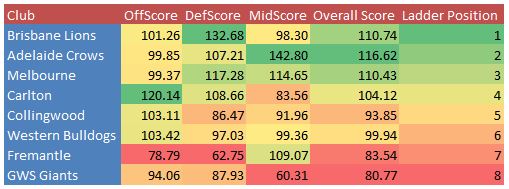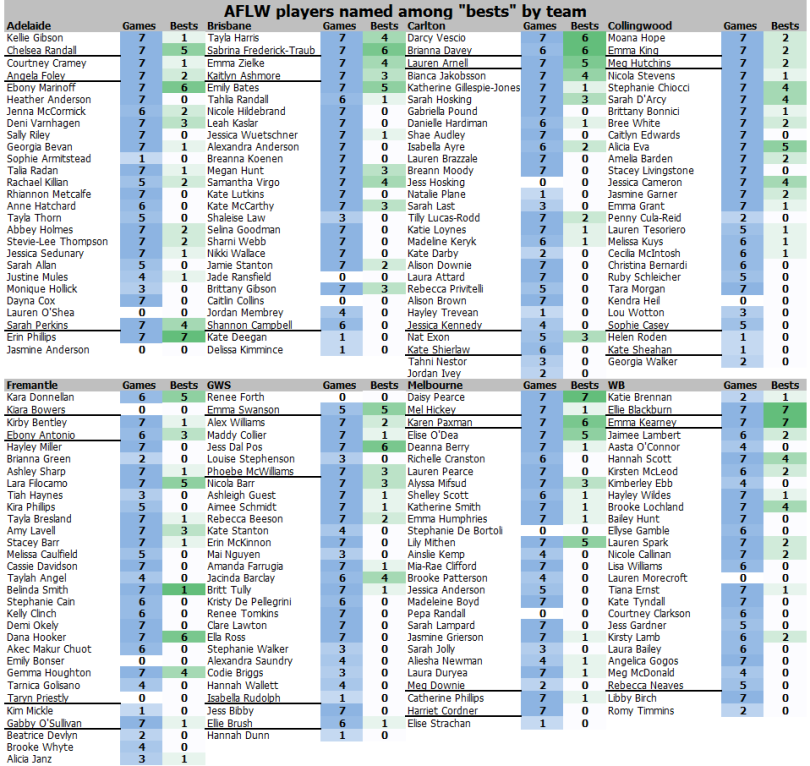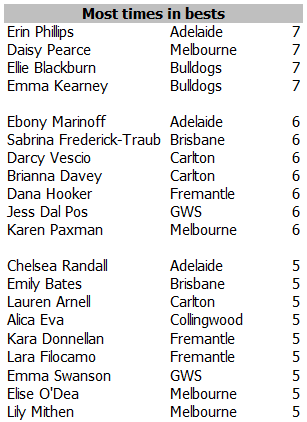The first AFLW Grand Final participants have been decided, after a weekend of relatively wacky results. As we outlined last week, Melbourne needed a record-setting win to maximise their chances of making the big game. Whilst the Dees managed the record-breaking 70 points, and a big 54-point win, it wasn’t quite enough to make Adelaide worry about the margin of their win. The Dogs summarily took care of the Giants in Canberra to ensure GWS would take the wooden spoon, which set up Sunday for a frantic finish to the season.
Right up to the last quarter Collingwood looked like they would win the game – that is until Phillips, Perkins and co. took the game away from the Pies. With their four goal win, the Crows cemented their place in the last week, and killed off the chances of Melbourne, Collingwood and Carlton. Finally, although they were eliminated from finals contention, Carlton turned up to play, ending Brisbane’s winning streak at 6.
HPN’s AFLW Team Ratings
Last year HPN developed a team rating method for the AFLM competition. We thought we’d have a look at how they would stack up for the first AFLW season:

As an explanation, the different scores are based on:
- OffScore: Points per inside-50.
- DefScore: Points conceded per inside-50 conceded.
- MidScore: Inside-50 per inside-50 conceded.
Each rating tells a slightly different story. The MidScore broadly describes how effective a team is at creating scoring opportunities for their side, and denying those of their opponent – a ball movement index in essence. The OffScore describes how efficient a team is once the ball is pushed up forward, whilst the DefScore explains how good a team is at stopping their opposition from scoring. All three measures are presented relative to league average, of 100, so a score of 105 is above average, and a score of 95 is below average.
As you can see, the ratings largely match the final overall places of the ladder. While the margins are slim, Adelaide and Brisbane rate as the two highest rated teams overall, slightly ahead of Melbourne (who were relatively unlucky to miss the GF). The Bulldogs were probably a bit better on paper than their final win-loss record suggested, while the Blues (led by Darcy Vescio) were the most potent team up forward by a considerable margin.
Breaking down the Grand Final
Quick hat tip – there has been some really solid AFLW work undertaken by FMI, PlusSixOne, Footy Gospel, Girls Play Footy and probably a bunch of others we are forgetting here. If you are as excited for this weekend’s showdown as we are, take some time to click a few of those links.
The Crows-Lions match-up not only presents the two strongest teams of AFLW playing off against each other, but also two teams with considerably different styles. As demonstrated above, the Crows have been, by a very long way, the best MidScore side in the competition. They have not only got the ball inside 50 at a prodigious rate, but denied their opponents from doing so. For the Crows, Erin Phillips, Ebony Marinoff and Chelsea Randell have led from the front, all sitting in the top 6 for inside 50s competition wide.
Brisbane, by contrast, has been phenomenal at defensively soaking up opposition attack after attack. We don’t have an inside-30 stat, which would possibly be more relevant to the AFLW’s usual scoring range, but anecdotally we’d suggest the Lions also keep the ball out of that tighter arc extremely well, with a lot of inside-50s being shallow entries.
Whilst the Lions’ defenders were not highly credentialed coming into the competition, Kaslar, Virgo and co. have established themselves as the form unit of the entire competition. When the pressure becomes overwhelming, the Lions have a tendency to throw Harris or Frederick-Traub down back to limit the option of the high bomb, forcing their opposition to find another way to goal.
This dichotomy of strengths is similar to last year’s AFL Grand Final, which pitted the defensively outstanding Swans against the ever-swarming Bulldogs midfield. For that game HPN suggested that:
“HPN usually refrains from picking outright results in games (as not to look like pontificating fools), but instead tries to pick the paths to victory where possible. For the Bulldogs to win, they must dominate the territory battle between the arcs, deny the Swans chances to get the ball forward, and to wear down the Swans defenders with repeat entries.
For the Swans, they must aim to turn a likely superior ruck performance into an increased number of inside-50s (as compared to last week against the Cats). The Swans must exploit their apparent advantages up forward, and trust that their defence will hold up to repeated (but not constant) attacks down back.
It should be a fascinating game to watch, given the differing strengths of each team.”
We suggest that a similar story might emerge from the game on the weekend, with different names involved.
For the Crows to win, the weight of inside-50 entries will have to be immense to breakdown the Lions’ defensive wall. Adelaide will also have to rely on multiple paths to goal, both small and tall, to counter Brisbane’s multifaceted defensive approach.
For Brisbane, the key will be slowing down Phillips, Marinoff and Randall, a feat easier said than done. If they are unable to do that, the game becomes tough for the Lions – but not impossible. The Lions would then have to rely on their aforementioned defensive prowess, but perhaps more importantly maximise on their few entries forward to score.
The last time these two sides played, in early March, the Lions took a slim three point win against the odds and away from home. The Crows massively won the inside 50 count (36-18), but were utterly unable to turn the repeated pressure into scoring opportunities. Adelaide was only able to secure four marks inside 50 from their plethora of entries – with Brisbane getting the same from half the number of forays.
If there is a silver lining from that game for Adelaide, it is that they had more scoring shots but lost; a sign that they were able to at least get the ball into position to score. The Crows will likely win the battle at ground level, and if they can do slightly better in the air they should be able to take the premiership.
For the Lions, their biggest positive sign is that they were able to win without a single goal from the two marquee forwards (Harris and Frederick-Traub). Both players had an impact on the game, but they were able to still score in other ways, such as through the severely underrated Kate McCarthy and Emily Bates.
With all said and done, the AFLW Grand Final shapes as a fascinating battle between two well-matched teams.
Best player leaderboards and a look at potential All-Australians
The following table shows the number of games played and the number of times named in the AFL.com.au bests for every player in the league. While the bests lists are seldom perfect, the repeated emergence of the same names should tell us who are some of the best players most likely to be fancied for MVP and AA honours.

The notably hard-done-by players tend to be those with less fashionable roles such as rucking and defending. Leah Kaslar at Brisbane (zero nominations) may have been in the best couple of defenders in the league, while the two premiere rucks in the league, Emma King at Collingwood (two) nominations) and rising star Erin McKinnon (zero) were also overlooked a few times.
We’re left with a “leaderboard” on this count that looks like this:

The goalless Darcy Vescio probably had her first real down game even as Carlton almost rolled the rampant Lions. The other players with perfect records maintained them, and any of Phillips, Pearce, Blackburn or Kearney would be a worthy MVP. Emma Swanson, notably, also has been among the Giants’ best in all five of her outings with them.
